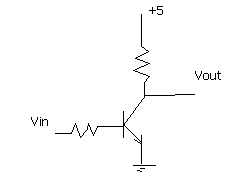sh3rmy
Newbie level 2
logic gates transistors
I am just learning about electronics and i understand how transistors work but I am having trouble with the math side of things. I am studying the single transistor inverter (which I have drawn very poorly below).
If i have a datasheet for the transistor i wish to use, what information do i need, and how do i use it, to work out what resistors I need?

I was told to use a 10kohm resistor on the base, and a 100ohm resistor on the collector, but why? no one can seem to explain it to me. Can anyone help me?
Thanks muchly,
Michael
I am just learning about electronics and i understand how transistors work but I am having trouble with the math side of things. I am studying the single transistor inverter (which I have drawn very poorly below).
If i have a datasheet for the transistor i wish to use, what information do i need, and how do i use it, to work out what resistors I need?

I was told to use a 10kohm resistor on the base, and a 100ohm resistor on the collector, but why? no one can seem to explain it to me. Can anyone help me?
Thanks muchly,
Michael